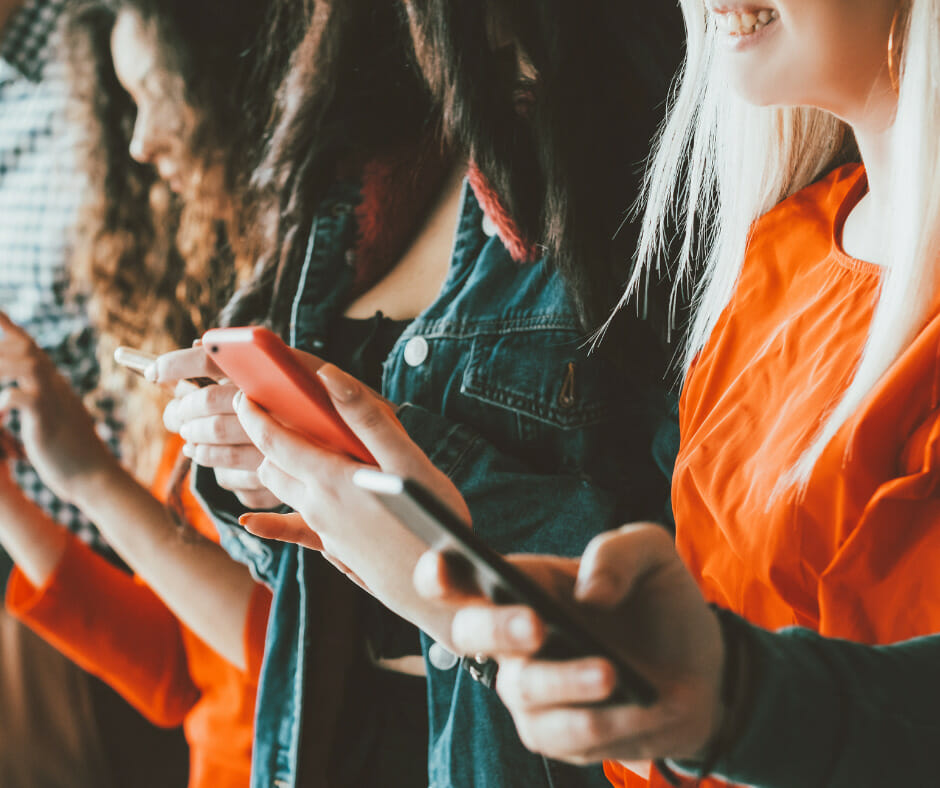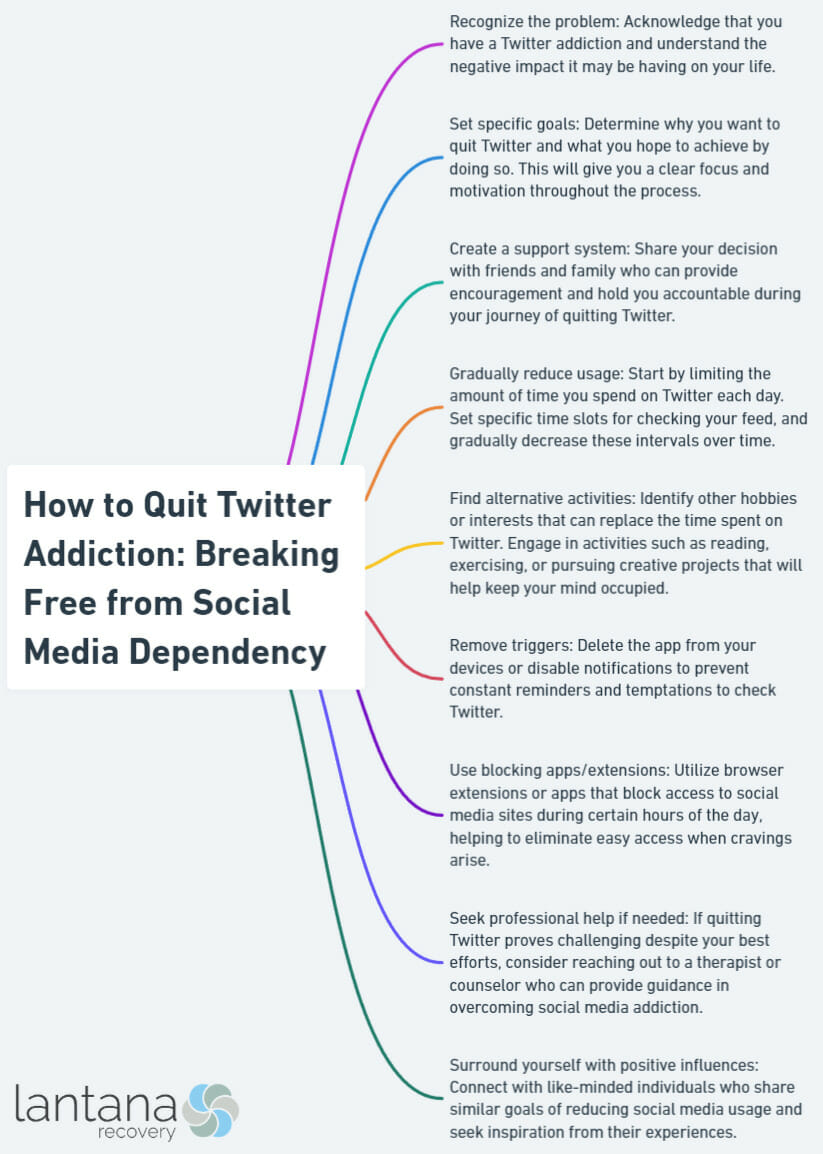Twitter addiction is a real phenomenon that affects many individuals in today’s digital age. The constant need to check notifications, the neglect of real-life activities, and the growing tolerance for social media use are all signs of dependency. Understanding the negative effects of Twitter addiction is crucial in recognizing the need for change. It can lead to a decline in productivity, impaired relationships, and even mental health issues. Breaking free from Twitter addiction requires concerted effort and a step-by-step approach. Setting clear goals and boundaries, creating a healthy social media routine, finding alternative activities, and seeking support are all essential steps in the process. Overcoming challenges such as FOMO and withdrawal symptoms, while practicing self-care, is key to staying motivated. Ultimately, it’s about embracing a balanced digital lifestyle that prioritizes overall well-being and real-life connections.

Understanding Twitter Addiction
Understanding Twitter addiction is crucial. Twitter addiction refers to the excessive and uncontrollable use of the social media platform, Twitter. This addiction can have negative effects on a person’s mental health and overall well-being.
There are several factors that contribute to Twitter addiction. Psychological factors such as the need for validation and attention, fear of missing out (FOMO), and the constant desire for social interaction play a significant role. Additionally, social influence, including peer pressure and constant comparison to others on Twitter, can contribute to addiction.
Another factor is escapism, where individuals use Twitter excessively as a way to distract themselves from real-life problems or to cope with feelings of loneliness and boredom. The unlimited access to Twitter through smartphones and other devices also makes it easy for individuals to continuously check and engage with content. Furthermore, the instant gratification that comes from receiving likes, retweets, and followers on Twitter reinforces addictive tendencies.
Understanding these factors is essential in developing strategies to overcome Twitter addiction. By acknowledging the underlying causes and adopting healthy habits, individuals can regain control of their time, prioritize their well-being, and improve their relationship with social media.
In a survey conducted on the students of a Malaysian university in 2020, it was found that 34% of Twitter users admitted to feeling addicted to the platform, indicating the prevalence and impact of Twitter addiction. Excessive use of Twitter has also been linked to poor sleep quality and decreased productivity. These findings underscore the importance of addressing Twitter addiction to promote mental well-being in the digital age.

Signs and Symptoms of Twitter Addiction
Are you constantly glued to your Twitter feed, unable to break free from the grip of social media? In this section, we’ll uncover the telltale signs and symptoms of Twitter addiction. From compulsive checking and neglecting real-life activities to increased tolerance and anxiety, we’ll explore the alarming red flags that indicate a dependency on this popular platform. It’s time to face the harsh reality and take decisive steps towards reclaiming control over your online habits.
1. Compulsive Checking
Compulsive checking, a behavior associated with Twitter addiction, can have various negative impacts. Several factors need to be considered when analyzing this behavior. Firstly, the frequency of compulsive checking is high, as individuals with this tendency constantly reach for their phones to check Twitter, often interrupting other activities. Secondly, there is a strong sense of urgency for compulsive checkers to constantly stay connected to Twitter, leading to feelings of anxiety and restlessness if the platform is inaccessible.
Furthermore, spending excessive time on Twitter due to compulsive checking can greatly reduce productivity, focus, and efficiency. Additionally, individuals who engage in compulsive checking neglect real-life activities such as spending time with loved ones or pursuing hobbies. Ultimately, this behavior can result in strained relationships, poor academic or professional performance, and compromised mental well-being.
To overcome compulsive checking, it is important to establish boundaries. Creating a healthy social media routine can also be beneficial in breaking free from this addiction. Furthermore, finding alternative activities to engage in can help divert attention away from Twitter. Seeking support, if needed, is also crucial in this process. Embracing a balanced digital lifestyle is the key to regaining control over your time and attention, ultimately overcoming Twitter addiction.
2. Neglecting Real-Life Activities
Neglecting real-life activities is a common sign of Twitter addiction. Individuals who are addicted to Twitter tend to put their time on the platform above engaging in real-life activities, which can have a negative impact on their overall well-being and daily functioning.
One of the main signs of Twitter addiction is ignoring responsibilities. Twitter addicts often neglect their work, studying, and household chores, choosing instead to spend excessive amounts of time scrolling through feeds and interacting with other users.
Another consequence of Twitter addiction is decreased social interaction. Twitter addicts tend to withdraw from real-life social interactions and rely solely on the platform for communication. This can lead to strained relationships and feelings of isolation.
Twitter addiction also disrupts sleep patterns. Many individuals who are addicted to Twitter stay up late using the platform, which negatively affects their productivity, mood, and health.
Additionally, Twitter addiction can result in neglected hobbies and interests. People who are addicted to Twitter often lose interest in their previous hobbies and activities because they spend the majority of their time on the platform.
To address the issue of neglecting real-life activities, it is important for individuals to recognize the negative impact of excessive Twitter use. They should set boundaries and create a balance between online and offline activities. By establishing clear goals and dedicating time to responsibilities and real-life relationships, individuals can regain control and break free from Twitter addiction.
3. Increased Tolerance
Increased tolerance is a key indicator of Twitter addiction. It is a common pattern for addicted individuals to spend an excessive amount of time on Twitter. These individuals gradually increase the duration of their scrolling activities, driven by their desire for social engagement. They constantly seek stimulation and eagerly refresh their feed in search of captivating content. In their pursuit of Twitter, they may disregard negative consequences such as neglecting their responsibilities and straining their relationships. As their tolerance escalates, they engage in more intense interactions, constantly seeking validation through likes, retweets, or replies.
To overcome the challenges posed by increased tolerance and break free from Twitter addiction, it is crucial to establish clear boundaries and set goals for social media usage. It is vital to create a healthy routine for engaging with social media platforms and explore alternative activities to redirect attention away from Twitter. Seeking support from friends, family, or online communities can offer valuable guidance and hold individuals accountable during their journey towards recovery.
4. Anxiety and Restlessness
Anxiety and restlessness are typical indications of Twitter addiction. It is essential to address these concerns and find ways to manage them. The addictive nature of Twitter can significantly contribute to anxiety levels. The constant need to check for updates, likes, and comments can create a fear of missing out (FOMO) and anticipation, leading to heightened anxiety. Moreover, individuals may experience restlessness when they are not actively engaging with the platform. This restlessness arises from their constant desire for stimulation and dopamine release from notifications and engagement on Twitter.
“Even if overuse does not rise to the level of an ‘addiction,’ there are still many possible downsides, such as low self-esteem, increased isolation and loneliness, and anxiety or depression,” speculates a research study published in Cyberpsychology, Behavior, and Social Networking. (Tech Addiction? Take a Break Addressing a Truly Global Phenomenon, Brenda K Wiederhold, 2022)
Consequently, Twitter addiction can disrupt concentration and impede productivity on important tasks, further increasing levels of anxiety and restlessness. Additionally, excessive use of Twitter can interfere with regular sleep patterns, as individuals may stay up late to check notifications and engage with the platform. This lack of sleep exacerbates anxiety and restlessness. Ultimately, Twitter addiction, characterized by anxiety and restlessness, negatively impacts overall well-being, creating stress, reducing motivation, and instilling a sense of dissatisfaction.
Recognizing the presence of anxiety and restlessness is vital, as it signifies the need for change and the importance of seeking support to break free from Twitter addiction. Implementing various strategies such as setting boundaries, establishing a healthy social media routine, finding alternative activities, and practicing self-care can help individuals overcome the anxiety and restlessness associated with Twitter addiction.
Effects of Twitter Addiction
Twitter addiction can have a significant impact on various aspects of our lives. From a decline in productivity to impaired relationships and even mental health issues, the effects are far-reaching. In this section, we’ll uncover the consequences of Twitter addiction and delve into the alarming statistics and real-life stories that highlight the severity of these effects. Buckle up as we explore the hidden dangers that come with being hooked on social media.
1. Decline in Productivity
The decline in productivity is a result of Twitter addiction. Here are some factors to consider. When individuals spend excessive time on Twitter, they suffer from a loss of focus, leading to distractions and a lack of concentration on important tasks. As a result, their productivity decreases, and the quality of their work suffers. Twitter addiction often causes procrastination, as individuals find themselves scrolling through their feeds instead of completing essential tasks or meeting deadlines. This hampers effective time management, with users neglecting other responsibilities and commitments.
Moreover, constantly checking Twitter makes it difficult to switch between tasks and maintain a productive workflow, resulting in slower task completion and decreased efficiency. Additionally, addiction to Twitter can lead to decreased motivation for work as individuals focus on seeking validation, attention, or social engagement. This negatively impacts their drive to be productive. To avoid the negative effects of Twitter addiction on productivity, it is crucial to recognize the signs of addiction and set clear boundaries for social media use. Engaging in alternative activities during free time can also help. Seeking support from friends, colleagues, or professionals can aid in overcoming Twitter addiction and regaining productivity.
2. Impaired Relationships
Impaired relationships are a direct result of Twitter addiction. Twitter addiction can have negative effects on relationships in various ways. Firstly, it leads to a decrease in the quality time spent between individuals. Twitter addicts spend excessive amounts of time on the platform, which ultimately results in less time being devoted to loved ones. Consequently, this strains relationships and diminishes the emotional connection between individuals.
Secondly, Twitter addiction hinders effective communication. Constantly checking Twitter and engaging in virtual interactions diverts attention away from real-life conversations. This diversion impairs the development of strong relationships and impedes effective communication between individuals.
Furthermore, excessive use of Twitter distorts reality, leading to misunderstandings in relationships. These misunderstandings can cause conflicts and further hinder healthy communication between individuals.
In addition, Twitter addiction often leads individuals to neglect their responsibilities within relationships. This may include breaking promises or being emotionally unavailable. Such behavior breaks trust and puts a strain on relationships.
Lastly, prioritizing Twitter over relationships can result in emotional disconnection from loved ones. This emotional disconnection leads to feelings of loneliness, dissatisfaction, and resentment.
Recognizing the detrimental impact of Twitter addiction on relationships is crucial. It should motivate individuals to seek help and make positive changes in their lives. By breaking free from Twitter addiction, individuals can restore and nurture healthier relationships based on genuine connection and effective communication.
tables:
3. Mental Health Issues
In recent years, the increasing use of social media platforms, including Twitter, has raised concerns about its impact on mental health. Research has shown a strong correlation between excessive Twitter use and negative mental health outcomes. Mental health issues related to Twitter addiction can significantly affect a person’s well-being. Some key mental health issues that may arise include depression, anxiety, isolation and loneliness, and sleep disturbances.
- Depression: Excessive Twitter use can lead to feelings of sadness, hopelessness, and loss of interest in previously enjoyed activities. It can also contribute to negative self-esteem and self-worth.
- Anxiety: Twitter addiction can trigger anxiety, including social anxiety, as individuals may become overly concerned with their social media presence, compare themselves to others, and fear missing out (FOMO).
- Isolation and Loneliness: Spending too much time on Twitter can result in isolation from real-life social interactions, leading to feelings of loneliness and a lack of meaningful connections.
- Sleep Disturbances: Constant scrolling and engagement on Twitter can disrupt sleep patterns, causing insomnia or poor quality sleep, which can worsen mental health problems.
It’s important to note that the severity of mental health issues can vary from person to person. If you or someone you know is experiencing significant distress or impairment in daily functioning due to Twitter addiction, it is essential to seek professional help. Taking steps to break free from Twitter addiction, such as setting clear boundaries, establishing a healthy social media routine, and finding alternative activities, can improve mental well-being and overall quality of life. Remember, prioritizing mental health and seeking support is always important.
By prioritizing mental health and making conscious choices about social media usage, individuals can cultivate a well-rounded digital lifestyle that promotes overall well-being. Maintaining a healthy balance between online and offline activities is crucial in mitigating the risks and ensuring mental well-being in an increasingly digital world.
As the grip of Twitter addiction tightens, researchers have unveiled the intricate interplay between constant scrolling and stress addiction. To learn more about the addiction to stress and its connection to platforms like Twitter, explore this insightful resource.

Recognizing the Need for Change
Recognizing the need for change is paramount when it comes to overcoming an addiction to Twitter. It is crucial to comprehend the detrimental impact that excessive use of social media can have on both our well-being and productivity.
To begin with, it is vital to actively acknowledge the presence of an addiction as the initial step toward recovery. By recognizing the need for change, individuals can seize control of their behavior and make a conscientious effort to diminish their reliance on Twitter.
Understanding that social media addiction can significantly decrease productivity and overall mental health is also of great importance. Numerous studies have indicated that spending excessive time on platforms like Twitter can negatively affect concentration and the ability to concentrate on essential tasks.
Moreover, recognizing the need for change enables individuals to assess how their addiction may influence their relationships and social interactions. Excessive use of Twitter can result in a decline in face-to-face communication and impede the establishment and maintenance of meaningful connections.
Given the harmful effects of Twitter addiction, individuals can then make well-informed decisions concerning their social media usage. This may involve setting limits on screen time, seeking support from friends and family, or engaging in alternative activities that foster overall well-being and personal development.

Steps to Break Free from Twitter Addiction
Break free from the grips of Twitter addiction with these essential steps. Discover how to set clear goals and boundaries, create a healthier social media routine, find alternative activities, and seek the necessary support. Say goodbye to endless scrolling and reclaim control over your online habits. It’s time to regain focus, productivity, and well-being in this digital age. Let’s dive into the strategies that will help you break free from the chains of Twitter addiction once and for all.
1. Set Clear Goals and Boundaries
Setting clear goals and boundaries is crucial in overcoming Twitter addiction. It provides structure and accountability, enabling individuals to regain control of their social media usage. Here are the steps you can take to set clear goals and boundaries:
- Reflect on your social media usage. Assess the impact of Twitter addiction on your life, considering the time you spend on the platform and the negative effects it has on productivity, relationships, and mental health.
- Set specific goals. Determine what you want to achieve by reducing your reliance on Twitter. For instance, you can set goals like limiting your daily usage or abstaining from the platform for certain periods.
- Establish boundaries. Define rules and limitations to ensure that you adhere to your goals. You can use apps or browser extensions to block access during specific times or even delete the app from your phone.
- Create a support system. Share your goals and boundaries with trusted friends or family members who can help hold you accountable. Ask for their support and understanding throughout this process.
- Celebrate milestones. Acknowledge the progress you make along the way. Celebrate successfully adhering to your goals and boundaries, and recognize the positive impact it has on your overall well-being.
By setting clear goals and boundaries, you can regain control of your Twitter usage and reduce the negative effects of addiction.
2. Create a Healthy Social Media Routine
Creating a healthy social media routine is crucial for overcoming Twitter addiction. Follow these essential steps to create your routine:
- Set specific time limits: It is important to determine the amount of time you will spend on Twitter each day and commit to sticking to it. This will prevent excessive usage and help you regain control over your time.
- Establish boundaries: Decide when and where you will use social media. Avoid using Twitter during important tasks or family time. Allocate specific periods for social media usage and refrain from accessing it outside of those designated times.
- Practice digital detox: Take regular breaks from social media. Dedicate certain days or hours to completely disconnecting from Twitter. This will allow you to focus on other activities and reduce your dependence on social media.
- Foster offline connections: Engage in real-life activities that bring joy and fulfillment. Spend quality time with loved ones, pursue hobbies, or participate in physical activities. Striking a healthy balance between virtual and real connections is crucial.
- Limit notifications: Disable unnecessary notifications that constantly interrupt and distract you. Customize your settings to only receive important notifications, which will help reduce the urge to constantly check your phone or Twitter feed.
A real-life example that highlights the significance of a healthy social media routine is Jane, a college student. Jane noticed that her excessive use of Twitter was negatively impacting her academic performance and relationships. Determined to make a change, she set clear boundaries by limiting her Twitter usage to one hour per day. She also scheduled specific study periods where she turned off all social media notifications. By creating a healthy social media routine, Jane was able to regain focus on her studies, strengthen her real-life connections, and achieve a better work-life balance.
3. Find Alternative Activities
When overcoming Twitter addiction, it is important to find alternative activities to replace the time and energy spent on social media. Here are some ideas to help you discover new ways to engage and occupy yourself:
- Explore hobbies: Discover new interests and hobbies such as painting, playing a musical instrument, or gardening. Engaging in joyful and fulfilling activities will divert your attention away from Twitter.
- Exercise regularly: Regular physical activity is beneficial for your overall health and can help reduce addictive behaviors. Consider joining a gym, going for a run or walk, practicing yoga, or participating in a team sport. The endorphins released during exercise will boost your mood and provide a healthy outlet for stress.
- Cultivate mindfulness: Engaging in mindfulness practices such as meditation or deep breathing exercises will help you become more grounded and present in the moment. These techniques can be useful for managing anxiety or restlessness when you are not using Twitter.
- Socialize offline: Instead of relying on virtual interactions, make an effort to connect with friends and family in person. Plan outings, meet for coffee, or have meaningful conversations. Building and nurturing real-life relationships offers a sense of belonging and fulfillment that Twitter cannot provide.
Breaking free from Twitter addiction requires commitment and determination. By finding alternative activities that bring you joy and support your overall well-being, you can reduce your dependency on social media.
4. Seek Support
Seeking support is crucial when breaking free from Twitter addiction. It is important to have a strong support system that can provide encouragement and guidance throughout the journey of overcoming addiction. There are several steps that can be taken to seek support:
- Reach out to friends and family: It is essential to share your struggles with loved ones who you trust. This allows for understanding, empathy, and emotional support.
- Join a support group: Consider becoming a part of a group specifically designed for individuals with social media addiction. Connecting with others who are going through similar experiences can provide a sense of community and solidarity.
- Seek professional help: Contact a therapist or counselor who specializes in addiction. They can provide personalized strategies and techniques to help you through the recovery process.
- Utilize online resources: There are numerous online forums, communities, and helplines that can offer additional support and guidance. Take advantage of these resources to aid in your journey towards overcoming Twitter addiction.
Remember, seeking support is a sign of strength and determination to overcome addiction. Surround yourself with individuals who understand your struggles and can help you break free from the grip of Twitter addiction.

Overcoming Challenges and Staying Motivated
Breaking free from Twitter addiction requires overcoming challenges and staying motivated. In this section, we’ll explore practical strategies to tackle the fear of missing out (FOMO), cope with withdrawal symptoms, and prioritize self-care. Discover effective techniques, backed by experts, that can help you regain control over your social media usage and maintain your motivation throughout the process. Let’s delve into these essential aspects of quitting Twitter addiction and embark on a journey towards a healthier digital lifestyle.
1. Dealing with FOMO
Dealing with FOMO (Fear of Missing Out) is crucial when overcoming Twitter addiction. Here are some strategies to help you with that:
-
Recognize the cause: It is important to understand why you experience FOMO. Is it because you feel left out or fear being out of touch with news and trends? Identifying the reasons can effectively address them.
-
Set realistic expectations: Accept that updates and conversations on Twitter will always occur, but it is not necessary to be part of every single one. Recognize that it is impossible to keep up with everything and focus on what truly matters to you.
-
Practice mindfulness: Develop techniques to stay present and grounded. When feeling anxious about missing out on Twitter, take a deep breath and remind yourself that you control your time and priorities.
-
Cultivate real-life connections: Spend quality time with friends and family, engage in hobbies, and pursue fulfilling activities. Building enriching relationships and pursuing meaningful experiences will help reduce the fear of missing out on virtual interactions.
In 2021, a team of Polish researchers surveyed a group of over 500 young women to identify the causes of social media addiction and reported a strong correlation between social media addiction and loneliness, depression, and anxiety. Therefore by implementing these strategies, that help foster better mental, physical, and social well-being, you can gradually overcome FOMO and regain control over your time and attention, leading to a more balanced and fulfilling life.
2. Handling Withdrawal Symptoms
Handling withdrawal symptoms is crucial in the journey to conquer Twitter addiction. To effectively manage and cope with these symptoms, it is important to incorporate the following strategies:
- Recognize the symptoms: It is vital to understand and acknowledge the symptoms of Twitter withdrawal, which may include restlessness, irritability, difficulty concentrating, and cravings for social media. By recognizing these symptoms, you can better prepare for them and find ways to address them effectively.
- Create a support system: Reach out to friends, family, or support groups who empathize with your struggle and can provide encouragement and accountability. Having someone to talk to during challenging moments can greatly facilitate the process.
- Engage in alternative activities: Replace Twitter with activities that bring you joy and fulfillment, such as hobbies, exercise, reading, spending time in nature, or pursuing personal goals.
- Practice self-care: Prioritize self-care to reduce stress and promote overall well-being. This can involve getting enough sleep, eating nutritious meals, practicing relaxation techniques, and engaging in activities that help you unwind.
- Set realistic expectations: Breaking free from Twitter addiction is a gradual process. Be patient with yourself and understand that setbacks may occur. Celebrate small victories along the way and remain dedicated to reducing your dependence on social media.
By implementing these strategies and seeking support, you can effectively handle withdrawal symptoms and successfully overcome Twitter addiction.
If you are struggling to overcome any behavioral or chemical addiction, consider reading our article on how to stop any addiction.
3. Practicing Self-Care
Practicing self-care is essential when overcoming Twitter addiction. Here are strategies to prioritize your well-being:
- Take regular breaks: Allocate specific times to disconnect from Twitter and engage in recharging activities like walking, meditating, or enjoying tea.
- Set boundaries: Establish clear guidelines for Twitter usage. Determine the maximum daily time allowed and stick to it. Avoid Twitter during self-care periods.
- Cultivate offline hobbies: Explore activities like painting, playing an instrument, or reading books to divert attention from Twitter. Practicing self-care through engaging in offline hobbies is crucial.
- Practice mindfulness: Be present by doing deep breathing exercises, journaling, or practicing gratitude. Mindfulness reduces stress and promotes mental well-being. Practicing self-care through mindfulness can greatly benefit individuals struggling with Twitter addiction.
- Nurture relationships: Prioritize quality time with loved ones and engage in meaningful conversations, outings, or offline connections. Practicing self-care by nurturing relationships is essential for overall well-being.
- Take care of physical health: Engage in regular exercise, eat a balanced diet, and get enough sleep to maintain overall well-being and reduce reliance on social media. Self-care practices include taking care of one’s physical health.
- Seek support: Reach out to trusted friends, family, or professionals for help. Share struggles and create strategies together to overcome Twitter addiction. Practicing self-care by seeking support is crucial for individuals who want to break free from their addiction.
By implementing these self-care strategies, you can break free from Twitter addiction and cultivate a healthier relationship with social media. Remember to prioritize self-care as you navigate the digital world.
Embracing a Balanced Digital Lifestyle
When embracing a balanced digital lifestyle, several important factors need consideration.
- Manage time: Allocate a specific amount of time each day for digital activities. Set boundaries and create a schedule for social media use to maintain balance and prevent excessive screen time.
- Practice mindfulness: Be mindful of digital habits. Take breaks from screens, practice mindfulness exercises, and engage in technology-free activities to cultivate a healthier relationship with digital devices.
- Prioritize social connections: While social media can foster connections, remember the value of face-to-face interactions. Actively engage in real-life social activities and spend quality time with loved ones to enhance overall well-being and reduce digital dependency.
- Balance physical activity: Incorporate regular exercise into daily routines to maintain a healthy lifestyle. This boosts both physical and mental well-being, reducing the temptation to spend excessive time online.
- Set personal priorities: Identify and prioritize personal goals outside of the digital realm. Invest time and energy into hobbies, personal development, and meaningful relationships for a more balanced and fulfilling life.
By embracing a balanced digital lifestyle, individuals can enhance overall well-being and cultivate a healthier relationship with technology.
Remember, everyone’s journey towards balance will be unique. Experiment with different strategies and find what works best for you. It is a process that requires patience and self-reflection, but the benefits of a balanced digital lifestyle are worth it.

Frequently Asked Questions
How can I break free from my Twitter addiction and quit social media dependency?
To overcome a Twitter addiction, begin by acknowledging the issue and identifying addiction signs. Pinpoint triggers behind your usage, consider joining support groups, and gradually cut down Twitter time while adopting healthier activities and coping mechanisms. Reward yourself for progress to build a balanced digital life.
How can I limit my social media usage and break my Twitter addiction?
To overcome a Twitter addiction, effective strategies involve restricting usage: disable notifications, set time limits, use tools like “Daily Time Blockers,” establish focused usage hours, engage purposefully, and reward self-control achievements.
Where can I seek professional help to overcome my Twitter addiction and social media dependency?
If tackling your Twitter addiction proves challenging, seeking professional help is crucial. Reach out to therapists skilled in addiction or CBT, use addiction treatment referral services like SAMHSA’s National Helpline (1-800-662-HELP), and explore resources such as the Gestalt Institute of Cleveland for trauma recovery. Leverage health insurance for provider options or access state-funded programs and online treatment locators.
What are the warning signs of a Twitter addiction or social media dependency?
Some common warning signs include: – Constantly checking social media platforms, such as Twitter, throughout the day. – Feeling anxious or irritable when unable to access or check Twitter. – Having trouble completing tasks or focusing on other activities due to excessive Twitter use. – Isolating yourself from friends, family, or real-life social interactions.
Are there resources available to help me overcome my Twitter addiction and social media dependency?
Yes, there are various resources available to assist you in overcoming your Twitter addiction and social media dependency. Here are some valuable resources to consider: – SAMHSA’s National Helpline (1-800-662-HELP) is a confidential and free treatment referral and information service operating 24/7, which can connect you with local treatment facilities, support groups, and community-based organizations.
How can I get confidential and free support for mental and substance use disorders related to social media addiction?
If you need confidential and free support for mental and substance use disorders related to social media addiction, you can contact SAMHSA’s National Helpline at 1-800-662-HELP (4357). The helpline operates 24/7, 365 days a year and provides treatment referral and information services. It can connect you with local treatment facilities, support groups, and community-based organizations that can offer appropriate assistance. The helpline offers support in both English and Spanish. .









